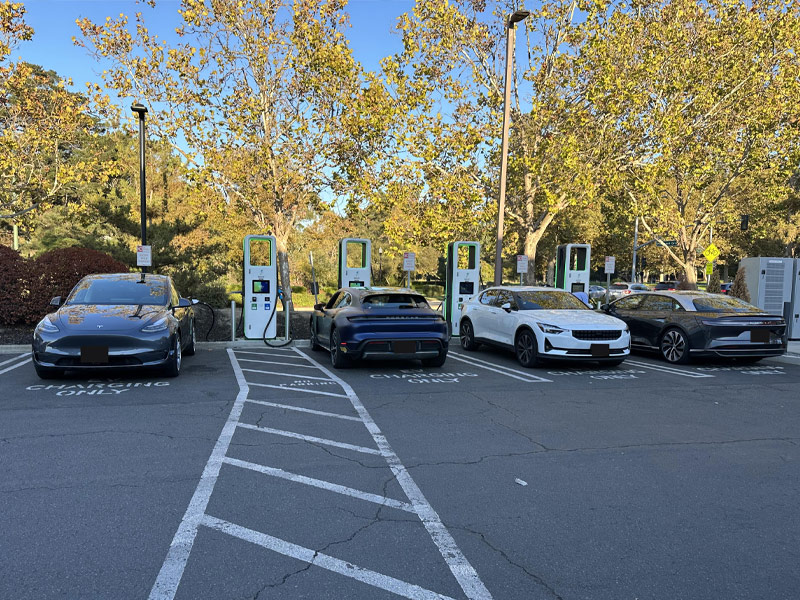The second quarter of 2025 marked a significant milestone in the expansion of the United States’ electric vehicle (EV) charging infrastructure. According to recent industry data, the country is on track for its most aggressive year yet in terms of new DC fast charger deployment. Key trends show larger station sizes, faster charging capabilities, and improving reliability across the network.
Key Highlights
- New Installations: Approximately 4,242 new DC fast-charging ports were added in Q2 2025 across 784 new stations, representing a 23% increase from the previous quarter. This brings the total number of fast-charging ports nationwide to around 59,700.
- 2025 Outlook: Forecasts suggest about 16,700 new DC fast-charging ports will be installed by year-end, representing a 19% increase over 2024 and positioning 2025 as the most expansive year on record for EV charger deployment.
- More Powerful Chargers: About 63% of newly deployed chargers in Q2 offer 250 kW or more in power capacity, a substantial increase from earlier in the year. The average number of ports per station also rose from 4.7 to 5.4.
Improvements in Reliability and Design
As newer fast-charging locations come online and older, less reliable units are phased out, the overall reliability index of the U.S. charging network has improved by over 5% compared to the previous year. Many of the new installations feature large-format designs with 8 or more charging ports, capable of delivering high-speed charging to multiple vehicles simultaneously. This evolution marks a shift toward what analysts are calling “Charging 2.0,” where stations are purpose-built for heavy-duty traffic and consistent performance.
Utilization and Pricing Trends
- Utilization Rate: The national average utilization rate for fast chargers dropped slightly from 16.6% in Q1 to 16.1% in Q2. While this decline was expected due to seasonal effects, the report cautions that some regions are experiencing a mismatch between the pace of charger installation and the rate of EV adoption.
- Pricing Changes: The average cost to charge dropped modestly from $0.50 to $0.48 per kilowatt-hour. A growing number of stations—especially in California—have adopted time-of-use pricing models. Overall, about 29% of stations changed their rates during the quarter, with some increasing and others decreasing fees.
Key Players Driving the Expansion
Several private companies are at the forefront of this expansion, building larger and more advanced charging stations in high-demand retail and travel corridors. This includes efforts from partnerships involving automakers, retail chains, and energy providers. Tesla continues to be a major contributor, accounting for roughly 40% of all new fast-charging ports added in Q2. Other major players include Electrify America and ChargePoint, each with growing market shares.
Global and Regional Context
Beyond the U.S., international infrastructure continues to grow, though at varied paces. In the United Kingdom, for instance, the number of public chargers increased by over 36% year-over-year, though the rollout has been uneven due to funding delays. Back in the U.S., California alone accounted for over 100,000 zero-emission vehicle sales in Q2, making up more than 21% of all new vehicle purchases in the state—despite changes in federal EV policies.
Summary Table: U.S. Charging Trends in Q2 2025
| Metric | Q2 2025 Value |
|---|---|
| New DC Fast Ports | ~4,242 |
| Total DC Fast Ports | ~59,694 |
| New Stations Opened | ~784 |
| Average Ports per Station | ~5.4 |
| Share of Ports ≥ 250 kW | 63% |
| Reliability Improvement | +5.3% Year-over-Year |
| Utilization Rate | 16.1% |
| Average Price per kWh | $0.48 |
Final Takeaway
Despite evolving federal policy and growing pains in adoption, the U.S. EV fast-charging network is rapidly expanding in both size and sophistication. With stronger infrastructure, smarter pricing models, and a new generation of large-format stations, the industry is laying the groundwork for widespread EV adoption across all regions. The pace of deployment suggests a proactive approach—building ahead of demand and betting on the momentum of the EV market.

Leave a Reply